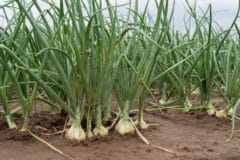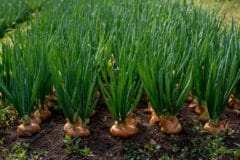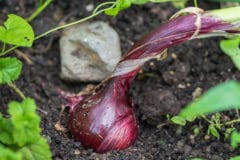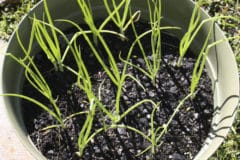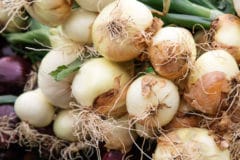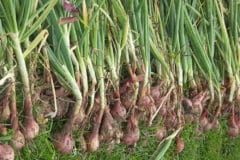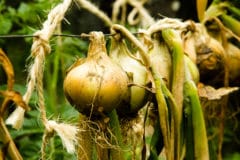Harvesting Red Onions
Keep an eye on your red onions growing in the garden for signs of maturation. When you see the onion stalks fall over and start to dry out, that’s a sure sign that they’re ready for harvesting.
All you have to do is gently pull the onion bulbs out of the soil, leaving them in the garden to dry out naturally. This can take up to two weeks. If the forecast in your area predicts rainy weather, gather your bulbs and place them in a cool, dry place until they’re dry. Once the onion skins feel papery and the stalks are dried out, you can store your red onions.
Storing Red Onion Bulbs
Red onions, yellow onions and white onions are all stored using the same methods. Store your onions in a cool, dry area with a temperature from 35°F (1.6°C) to 55°F (12.7°C), such as a vegetable closet, basement, root cellar, garage, shed or unheated closet. If the temperature drops below 32° (0°), then move the bulbs to a warmer location to prevent frost damage. Follow these steps for storing red onions:
- Brush off any dirt from the onion bulbs.
- Cut the onion tops off to within 1 to 3 inches from the bulb. If you’re planning on braiding your onions together, skip this step.
- Trim the onion roots from the base of the bulb.
- Leave the papery skin on the bulbs.
- Store the onions in your chosen location.
Dehydrating Red Onion Slices
You can also dehydrate your red onions, so they’re recipe ready. Once dehydrated, you can also grind them into a powder for sprinkling on foods for a zesty flavor. Dehydrating onions is easy and a convenient way to store them:
- Remove the papery skin from the onions.
- Rinse the onions to remove any dry, skin particles.
- Slice off the onion tops and bottoms of the onions.
- Cut the onions into one-eighth to one-quarter-inch slices.
- Place the slices in a single layer in your dehydrator.
- Follow the manufacturer’s recommendations for drying time needed for onions.
Freezing Diced or Sliced Red Onions
If you don’t have a dehydrator or would rather freeze your onions, that’s a handy alternative. Frozen onions retain their flavor and save time when it comes to adding them to your recipes. Follow these simple tips for freezing your red onions:
- Remove the dry skin from the onions.
- Rinse off any leftover particles from the onions.
- Chop or dice the onions into desired sizes. You don’t have to blanch them.
- Place the diced onions in freezer bags.
- Press the freezer bag flat to remove excess air.
- Seal tightly and place the bags in the freezer.
Once you freeze your onions, just break off pieces as needed. Frozen onions are best for soups, stews, casseroles, meatloaf or any other recipes that call for chopped onions. Keep in mind that thawed onions do become mushy, so they’re not suitable for salads or any recipes that need crunchy onions.



